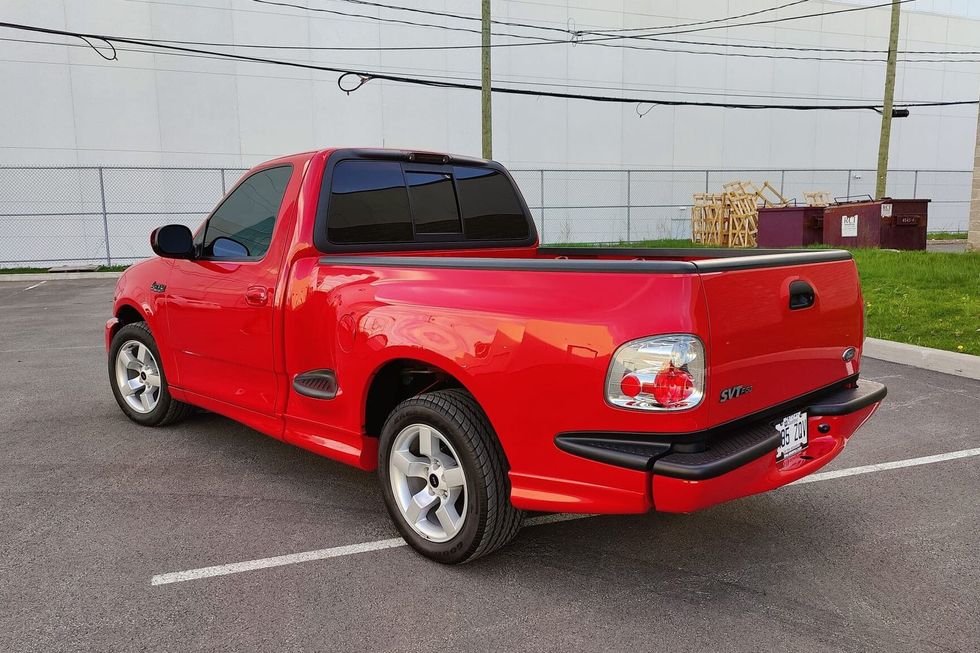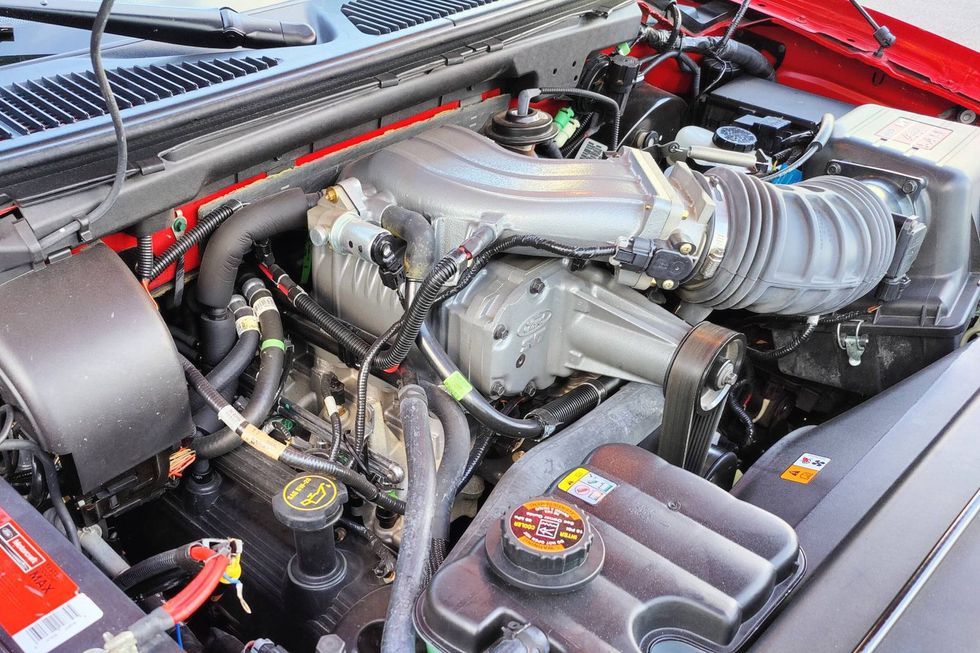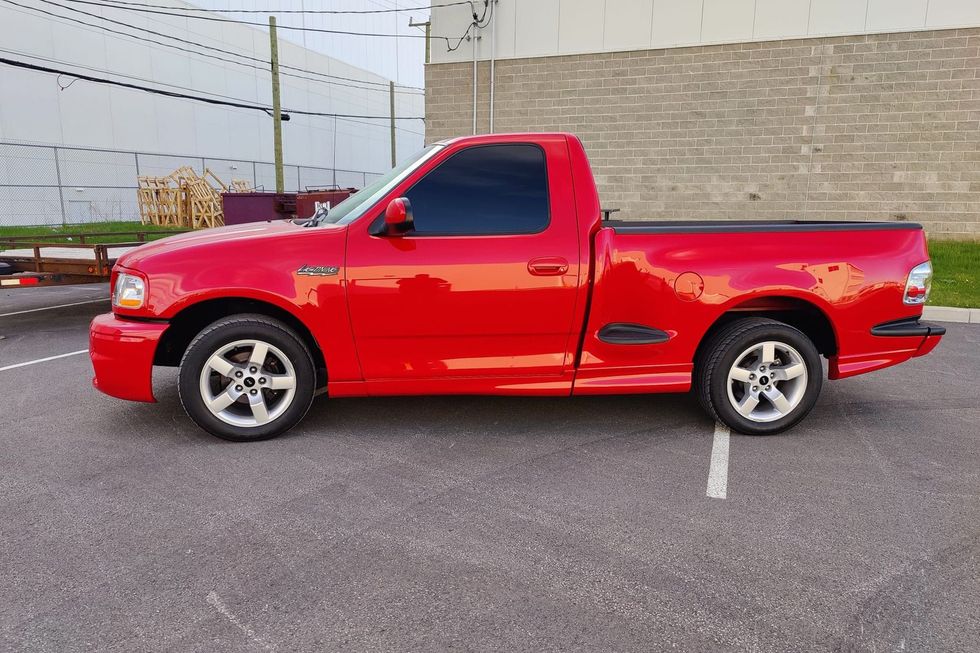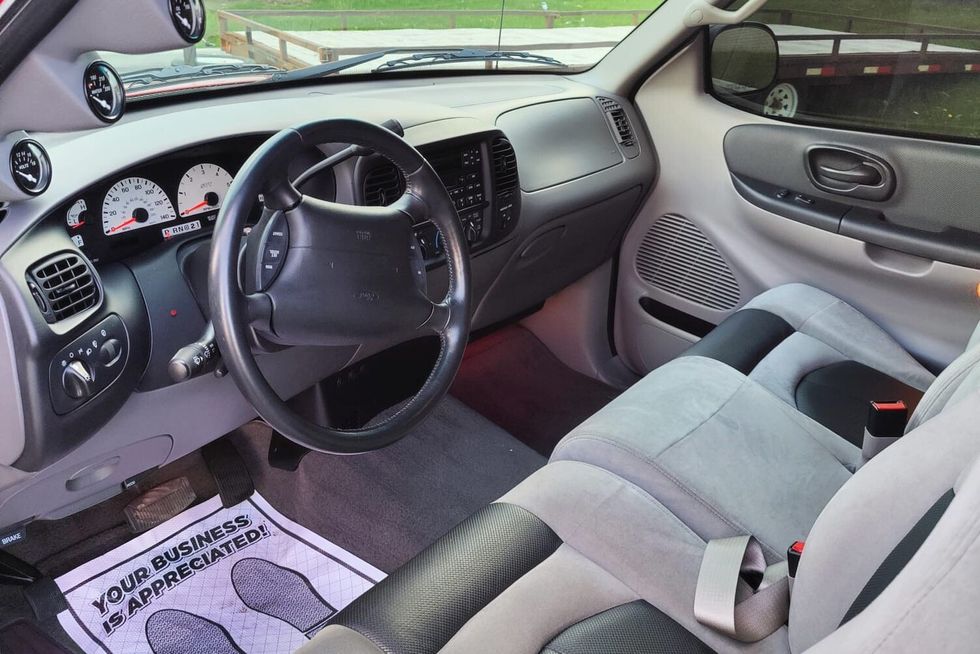It’s a buyer’s market for Ford’s final T-Bird… for now
2002-’05 Ford Thunderbird Buyer's Guide
08/31/2020


Ford's two-seat, V-8 Thunderbird concept was a show-stopper on the 1999 car-show circuit. Created under the watchful eye of Ford design legend Jack Telnack, with details seen to by J Mays after Telnack's 1997 retirement, it was sporty without being a sports car, luxurious without costing an arm and a leg, elegant yet modern, and comfortable without being excessive. Some fuss was made about the 11th-generation Thunderbird's modern-retro style at the time: the eggcrate grille and driving light nacelles, the non-functional hood scoop, the round twin rear lights, the chromed script badging, the removable hardtop with the porthole, and the generous proportions with ample rear overhang. But these could easily just be seen as touchstones on an otherwise modern shape.
The production car's platform was shared with the Jaguar S-Type (and later, the Jaguar XF) sedan. The Thunderbird also shared its platform with the Lincoln LS sedan. Its much-heralded arrival as a 2002 model, with the first models built in 2001, ensured a 19-month initial production run and sales numbers that far outstripped Ford's 25,000-unit-per-annum estimate. More than 31,000 T-Birds, or 46 percent of all 2002-'05 T-Bird production, were '02s. For this reason, production can easily be broken into two groups: 2002s and the rest.
Ford updated the Thunderbird annually with special editions and exclusive paint colors. Torch Red and Evening Black are the only colors that lasted all four years. Whisper White was available in 2002-'03, Thunderbird Blue (an aqua metallic) in '02 only, and Inspiration Yellow was also an '02-only color. Mountain Shadow Grey and Desert Sky Blue were only for '03, as was Silver, Merlot, and Ice Blue were '04-only hues, while Monterey Mist was an exclusive for the Pacific Coast Roadster edition. Bronze, Medium Steel Blue, Cashmere, and Inca Gold only appeared in 2005. Of these, Inca Gold is the rarest of all T-Bird colors, with just 187 built.
Production ended in July 2005 with barely 68,000 built over four years. It wasn't a huge sales success in Ford's eyes, but the most recent Thunderbird still outsold the original two-seat T-Bird by 15,000 units and lasted a year longer. With the oldest of these cars coming up on two decades in age, it's still possible to find a clean, low-mileage example out there.
For this buyer's guide, we spoke to two people: Philip Wegener of Thunderbird Specialties, an online-based shop that deals exclusively with parts for the 2002-'05 Thunderbird, and Ken Berger of Phoenix, Arizona, a serial T-Bird buyer (nearly a dozen since his first new one in late '01) who owns our Torch Red '02 feature car. Between them, a clean picture of what to watch out for emerges.
Body
The body was unchanged during the T-Bird's four years of life, although a discreet V8 badge appeared on the fender behind the front wheel opening on '02 and '05 models only. Philip noted that "Doors and rear quarter panels are unavailable from Ford, although the front and rear bumper covers are still available through the dealer." The hood and trunk lid are both made of sheet-molded composite and are also not available from the dealer.
Philip suggests that the bulk of Thunderbird owners babied their cars, making plenty of good-quality, low-mileage examples readily available. Rust typically isn't an issue: He's found that "most put their Thunderbirds in hibernation from October to April."
Something to note is the boot that covers the folded soft roof. "The '02 soft boot took up most of the trunk," Ken said. "In '03, Ford went with a different padded multipiece design that could be folded and stored. I think it's an improvement. And the snap configuration is the same—any boot will fit any year."
Also, the optional hardtop can leave rub marks between the trunk lid and the soft-top well. "Any hardtop is going to do that," Ken said. "The factory put the tops on when paint was still fresh." The factory offered a hardtop protection kit consisting of mylar strips, gel, and an applicator. Thunderbird Specialties still has a few sets in stock, though it has developed a stainless- steel protection strip said to prevent scratches and reduce rattles and squeaks in the hardtop.
Electronics
One of the things that scares collectors about modern cars is the cost and complexity of fixing various computer systems. "The one that fails most is the FEM, or Front Electronic Module, lighting," Philip said. "I must get five calls a day from people who need an FEM, but Ford obsoleted it in 2018. There are also the PCM, or powertrain control module, and REM, the rear electronic module." What's more, each module is vehicle-specific—you can't just plug one in you scrounged at a boneyard and make everything right again. Because of this demand, Philip reached out to Ford, and prevailed upon it to do something. Ford did: Through Thunderbird Specialties, and not through standard channels like your local dealer's parts department, Ford will remanufacture the FEM. "There's a high core charge, and you need lots of information— the part number, your car's engineering number, the odometer reading, the VIN, the owner's name, and the old core."

Interior/Top
Small but significant interior differences separate the 2002 and the 2003-'05 models. The 2002 gauge cluster was unique, with the gauge faces arranged to appear as if they overlap. The 2003-'05 gauges are their own individual semi-circles. The 2002 has a hook on the glovebox latch (presumably for a trash bag); it disappeared in '03 and never returned. The '02 model has vinyl sun visors, while the 2003-'05 has cloth. Subtle differences in material and color can help identify one year from another. Optional complementary body-colored interior trim was available with some colors.
"Rattles and squeaks from the hardtop generally come from improper attachment," said Philip. "There are two clamps in back and two bolts in the header; if it's not done in sequence" then noise can crop up. All years of hardtop will fit any 2002-'05 T-Bird, regardless of whether it was equipped with one at the factory or not. Hardtop-equipped models came with a folding hardtop rack for storage when not in use.

The convertible soft-top latches have plastic bushings that deteriorate and crack, releasing a spring, and the pivot arm can also break. This is "in the top five of overall issues with the Thunderbird," Philip said. "Repair kits are available from Ford. It sells an entire clamp assembly; Thunderbird Specialties sells individual components." And watch for a worn or weather-beaten convertible top as well.
Other issues include a six-CD changer that will neither return nor play your music (occasionally fixable by disconnecting the battery and letting the electronics reset; otherwise the unit needs to be opened and re-lubricated), seat leather than can crack or fade, and the inner door handles. "They work fine, but the chrome peels. Little stuff like that is annoying," Kenny said. According to Philip, "Inner door handles are increasingly difficult to find; the handle is riveted to the latch assembly and was never available separately. Disassembling and rechroming it is expensive, and with a used handle, you're replacing one 15-yearold part with another."

Engine
The Thunderbird's 32-valve DOHC V-8 displaced 3.9 liters (242-cu.in.), and despite the Jaguar architecture was a unique variant built in Lima, Ohio. The AJ30's block, crank, pistons, and fracture-split, forged-powder-metal connecting rods are all unique to this engine and are not shared with Jaguar. The 2002 version offered 252 horsepower at 6,100 rpm, and 267 lb-ft of torque at 4,300 rpm. For 2003, the updated AJ35 variant added electronic throttle control, variable timing on the intake camshafts, and an electric cooling pump (replacing a hydraulic unit) for reduced drag. Power was bumped to 280 horsepower at 6,000 rpm. The AJ35 ceased production in 2006, with more than a quarter-million built; AJ-architecture engines will cease production in September.
The biggest issue with Thunderbird engines is with the coil-on-plug ignition. Philip said, "I've heard from people with high-mileage cars who haven't had issues, and I've seen them go bad on cars from 20,000 to 70,000 miles. Motorcraft makes a correct replacement and, at $75-$90 each, they're not expensive, but labor is. And once one coil fails, the others won't be far behind, so you should do at least one bank of the V-8 at a time, if not all at once." Ken says that part of the problem is that "the valve covers leak, and oil fills the valley where the coil packs are and shorts them out. It's not a hard fix, but it's annoying. If you keep them dry, and if the gaskets are good, they'll go forever."

The transmission is Ford's 5R55E, an electronically-controlled five-speed automatic transmission. All 2002s and standard 2003-'05 models have a PRNDL shifter. Starting in 2003, the optional SelectShift (manumatic) shift pattern appeared.
"The transmissions don't get beat up much—the engine doesn't overpower them, which helps," said Philip. "The transmission is sealed—you can't even check the fluid level from under the hood. Most transmission issues, I have found, are caused by opening the system and creating problems that didn't exist before that. Oil change shops often underfill or overfill. Ford recommends just leaving it alone."
Brakes and Suspension
All of Thunderbird's factory wheels were 17 x 7.5, fitted with P235/50R17 95V Michelin Pilots. It's a common enough tire size, although some owners move up to a 55-series for a little more sidewall and ride comfort. The 2002-'03 has two available wheels: a painted silver 21-spoke or a chromed seven-spoke (the special Neiman Marcus and 007 editions got chromed versions of the painted wheel). The 2004-'05 models had a refreshed wheel selection.
The one tire to check on, though, is the spare. "The donut spare can blow up in the trunk from age," said Ken. "You gotta get it out. One day you hear a 'boom!' and you have a trunk full of rubber dust." Philip explains further: "They get dry-rotted over the years, and most owners never look at it. At 60 psi, it can explode and tear up the liner and panels of the trunk. And even if it's intact, if you put a load on it, it probably won't hold up. The 2002 spares were made by Firestone; they switched to another company after 2002. It's a special- order piece from a tire shop since most dealers and shops don't carry them, and should be less than $300."
The four-wheel independent suspension is very robust, Philip claims. Your local Ford parts counter and local parts store should have all of the other components needed to keep a 'Bird feeling fresh. Watch the bushings, however: They're hard nylon and can crack with age. Some Lincoln LS suspension parts are compatible with the T-Bird, none from the S-Type Jaguar are— despite riding on the same platform.
WHAT TO PAY
| Low | Average | High | |
|---|---|---|---|
| 2002 | $8,000 | $9,200 | $12,000 |
| 2003 | $8,600 | $9,800 | $12,700 |
| 2004 | $9,200 | $10,400 | $13,300 |
| 2005 | $9,200 | $10,400 | $13,300 |
PARTS PRICES
Climate control sensor $99
Coil spring $349
Convertible soft-top $1,699
Front bumper cover $995-$1,495
Front marker light $70
Fuel tank $899
Grille (chrome-plated) $388
Hood scoop $299
Hood support struts $129
Inner door handle assembly $589
Quarter molding $399
Rear shock assembly $162
Trunk liner $229
Valve cover $295
"V8" emblem $60
Wheel center caps $199
Wings trunk emblem $99
PHOTOGRAPHY BY JEFF KOCH
Forget Ford’s groundbreaking electric truck for a moment to consider this 2001 Ford SVT F-150 Lightning now offered on Hemmings Auctions. Instead of the dual permanent-magnet motors found in the current electric Lightning, the 1999-2004 SVT Lightning featured a supercharged version of Ford’s 5.4-liter “modular” OHC V8. Rated at 380 horsepower in the 2001-’04 models, it was good enough to make a stock lightning a formidable opponent on the street as well as at the strip.
A follow-up to the original 1993-’95 F-150 Lightning, which was a high-performance version of a standard F-150, the second-generation SVT super truck presented as a more thoroughly developed model with a lot more exclusive components that further differentiated it from the rest of the F-Series lineup. Beyond the engine, the entire suspension and braking system, not to mention aerodynamic body add-ons, were part of the Lightning package from 1999 through 2004. Exclusive interior components were also part of the package.
At the heart of this SVT Lightning is its iron-block 5.4-liter SOHC, 16-valve V8 with a supercharger and an intercooler. The blower helped it deliver 380 horsepower and 450 lb-ft of torque in 2001, up some 20 horsepower and 10 lb-ft from the ’99 and 2000 models. The Eaton supercharged engine delivered peak boost of 8.0 psi and the engine featured an 8.4:1 static compression ratio, down from the standard 5.4 V8’s 9.0:1, which was rated at 260 horsepower and 350 lb-ft.
Power reached the rear 18-inch cast aluminum-alloy wheels via a four-speed automatic, an aluminum driveshaft and a beefy 9.75-inch, limited-slip rear axle with an acceleration-friendly 3.73:1 final-drive ratio, another upgrade for 2001. Car and Driver magazine reported a 0-60 mph time of 5.2 seconds and a quarter-mile in an E.T. of 13.8 seconds at 104 mph—impressive numbers for a 4,600-pound truck. Top speed was a drag-limited 142 mph.

Trucks generally require a suspension that can handle a full load in its bed while also providing competent driving while empty. But if you fancy one designed to a sports-car standard, then something has to give. In the case of the second-gen Lightning, Ford dropped its payload capacity to a mere 800 pounds. A standard 2001 F-150 Styleside carried a 3,180-pound payload rating, while an F-150 Flareside was rated at 2,005 pounds, some two-and-a-half times the Lightning, which featured the short-bed Flareside body. Towing capacity, likewise, was reduced from 8,800 pounds to 5,000 in the Lightning. But the Lightning’s strengths were never its payload or towing capacities, but it’s ability to perform like a sports car.
As a 21st century performance vehicle, however, the second-gen Lightning was also equipped to handle. A half-inch drop at the front was accompanied by SVT-specific coil springs and Bilstein shocks along with an exclusive 31-mm solid anti-roll bar. SVT’s influence continued at the rear with Lightning-specific five-leaf springs and a 23-mm solid anti-roll bar. The Bilstein setup at the rear included the right-rear shock staggered toward the front of the truck to reduce axle hop under heavy acceleration. The four-wheel antilock disc brakes were cribbed from the three-quarter-ton F-250, with 12.1-inch front rotors at the front and 13.1-inch discs at the rear.

As the years go on, fewer and fewer clean, unmolested low-mileage examples are out there, which is why this 2001 Ford SVT F150 Lightning now on Hemmings Auctions caught our attention. Showing just 5,525.5 miles on its odometer at the time of submission, it is said to be in “mint” condition and have an “immaculate” finish in the seller’s words. No modifications are noted to any part of the vehicle. The 18-inch factory alloys don’t appear to have any curb rash, though the Goodyear performance tires may be original. About the only deviations from stock are the tinted windows.
The latest electric-only F-150 Lightning is certainly a quick vehicle in its own right, but this 2001 edition from the engineers at SVT was built for excitement, not range. It was made with an old-school muscle-car vibe along with modern handling and braking. Which Lightning would you look good behind the wheel of?
Take a look at this second-gen Lightning on Hemmings Auctions before the bidding ends.

Spring is here. As the snow melts and the daffodils bloom, it’s time for many vintage cars to emerge from winter hibernation and get back on the road. Thinking of adding to the collection? We have 10 vehicles in spring-like shades of yellow – including cars and trucks, U.S. and European – to catch your eye.

















































